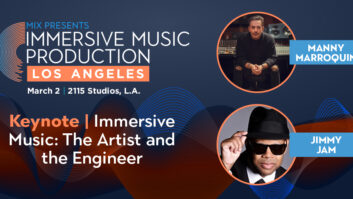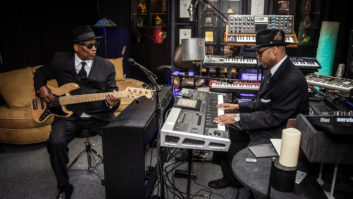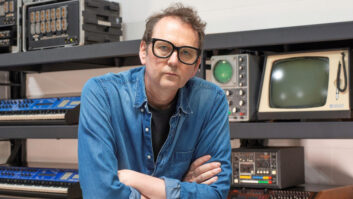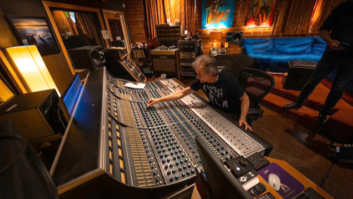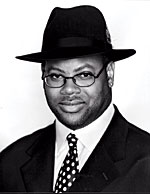
Prince must have kicked himself squarely in his purple paisleyderrière after firing his keyboardist and bassist back in 1983.Unaware of their seemingly limitless potential as musicians,songwriters and producers, the diminutive pop/R&B star axed JimmyJam and Terry Lewis, then members of Prince protégé MorrisDay’s band, The Time, and now arguably the most successful productionteam of the past three decades.
The Twin Cities natives and high school friends practically definedmodern R&B with their mix of edgy yet classic melodies,street-smart but sophisticated lyrics and funky beats. Fresh out of thestarting gate, their first production gig, a series of songs for theS.O.S. Band album, On the Rise, yielded a Top 5 R&B single(“Just Be Good to Me”), but also marked the end of theirreign with Prince, who did not allow bandmates to produce outsideprojects. “It was really one of the worst days of ourlives,” says Jimmy Jam on getting fired from his sideman gig.“We were perfectly happy being bandmembers at that point in time.But [getting fired] forced us to really take it seriously, and we werelucky to have lined up a couple projects at that point. All’s well thatends well, I guess.”
The unintentional career change certainly turned out to be ablessing in disguise, as the charmed two-some immediately pumped outsuccessful projects for Gladys Knight, Patti Austin and Klymaxx, beforeteaming up with Janet Jackson in 1985 to produce themultimillion-seller, Control, catapulting both artist andproducers to superstar status.

Their working relationship with Miss Jackson continues nearly 20years later. Jam and Lewis have produced all of her albums thus far,including the just-released Damita Jo. Their massive discographyalso includes megasellers from Mariah Carey, Boyz II Men, the SpiceGirls, Michael Jackson, TLC, Mary J. Blige, Patti LaBelle, ArethaFranklin and new R&B sensation, Heather Headley, as well asboundary-stretching acts such as Human League and Japanese artistHikaru Utada.
In addition to a seemingly inexhaustible creative supply that’sresulted in more than 40 Number One singles and more than 100 albumssurpassing Gold status, Jam and Lewis also have sharp business minds.Presently, the entrepreneurs own their own record companies(Perspective Records, Flyte Tyme Records), publishing companies (NewPerspective Publishing, Flyte Tyme Tunes) and private recordingstudios. The original Flyte Tyme Productions, opened in 1982 inMinneapolis, has grown to become a sprawling 17,000-square-foot complexin nearby Edina, Minn., containing five studios, a rehearsal facilityand one serious game room.
This year, the dynamic duo expanded their enterprise yet again,launching Flyte Tyme West, a five-room facility temporarily housed atThe Village Recorders in Los Angeles. The West Coast site will allowthem to devote more of their time and talents to the film, televisionand advertising industries, an interest that first surfaced in themid-1990s. Their soundtrack work includes such films as How StellaGot Her Groove Back and Mo’ Money, the Janet Jackson —starring Poetic Justice, Prince of Egypt, The BestMan and The Fighting Temptations, which they also scored andmusic-supervised. During the last year, Jam and Lewis composed tracksfor The Gap and FreshLook Contacts commercials, and produced music forthe 2004 NBA All-Star Game, as well as India.Arie’s song, “LookWith the Eyes of Your Heart,” for the Radio soundtrack andA Shark’s Tale, starring the voices of Robert De Niro and WillSmith.
Despite the buzz of recent film activity, Jam and Lewis continue tocrank out top-tier pop and R&B albums. At the time of ourconversation, the team was working simultaneously on albums for JanetJackson, Usher, New Edition, Mariah Carey and Yolanda Adams — allat Flyte Tyme West.
With 30 years of friendship and more than 20 years of “FlyteTyme” logged, Jam and Lewis produce consistently cutting-edgemusic not by following trends but by looking at what’s ahead.Furthermore, by treating their clients and each other with respect,they’ve enjoyed career longevity in an industry known more for spittingout one-hit wonders than developing long-term success. Dressed in histrademark black suit and hat, Jam spoke openly about the productionphilosophies he shares with Lewis, the Flyte Tyme evolution and thetechnology they’ve adapted to along the way.
Your career exploded when you started working with JanetJackson. Were you prepared?
At the time we signed on to do Janet’s [album], it was at a point inher career where, as an artist, she hadn’t really achieved a high levelof success. It’s just an instinct thing. Literally, John McLain, whowas the A&R person for A&M at the time, gave us the roster andsaid, “Pick somebody.” We picked Janet, and he asked,“Do you want to do a couple of songs?” And we said,“No, we want to do the whole album.” We really felt likethere was something there and wanted to work with her.
The difference in what we did was that we asked her opinion and gother involved in the actual writing process, so the ideas that cameforth were her ideas — the ideas of an 18-year-old girlstriking out on her own — and it touched a chord with people. Atthat time, there wasn’t really a girl singing over funky tracks likethat. It’s almost like we were doing the tracks like what we would dofor a male artist, but she had so much attitude when she sang that ittotally worked. It was fun watching her get excited about recordingbecause up to that point, I don’t think she was that enamored with therecording process, but once she had a chance to have input and knewthat her ideas were actually going on the record, that’s when she gotexcited, and I think that made all the difference in the world.
Of all the producers we talk to, each one has a differentanswer as to his or her role in the studio. What is it for you andTerry?
To get the best performance from the artist, very akin to what adirector does with actors in the movies.
What you’re doing is you’re kind of reading and assessing, and youactually end up having a very intimate relationship with the artist,because they have to trust you to let their guard down, to let you knowtheir feelings and let you get a great performance out of them. Youcan’t give a great performance when you’re holding back and thinkingabout what you’re doing, so you try to take their mind off of any sortof pressure.
For the Control record, the first week Janet came toMinneapolis, we didn’t even go into the studio and record. We just hungout. We went and hung out at the lake, went to clubs, and just talkedand got to know each other. At one point, she asked us, “When arewe going to start working on the record?” And I said, “Wealready started working on it.” Because, really, we were tryingto learn what she was about. Then we showed her some lyric ideas andconcepts we came up with, and she said, “Wait a minute, this iswhat we’ve been talking about,” and I said, “Yeah.”And she said, “So whatever I have on my mind, that’s what we’regoing to put on the record?” And I said, “Yeah,” andthat made it exciting for her. That to me is all part of the producerprocess.
It’s a very collaborative process for us. We try to tailor-make eachsong and each recording to the specific artist rather than do a bunchof songs and pull them off the shelf. When you do that, you end up withthe artist’s personality truly in the record, and they feel thatthey’re part of the creative process.
So does your level of input in the songwriting and arrangingprocess vary with each artist?
Yes, because sometimes an artist doesn’t physically write, but theycan tell you how they feel. You can pick up a certain phrase that theysay or a thought that they have about a certain subject, and thosethings lead to song ideas. Mariah Carey, for instance, is very muchinvolved in the songwriting process. We sit in a room with her —usually myself, Terry and a couple of the other Flyte Tyme musicians— and we’ll bang out maybe 10 or 12 ideas in a two- or three-hourperiod. Not fully realized, but just enough to know whether we’re goingdown a path that we like. It could be based on a keyboard lick that Iplay or it could be based on just us having a discussion aboutsomething. It’s a collaborative effort, but she’s very much asongwriter in the sense that she enjoys the lyric-writing process andputting the format of the song together — whether it should havea modulation at the end, whether it should have a double chorus, etcetera. Janet is sort of the same way.
And then there are people like New Edition. They’ll have abrainstorming session, talk about the million ideas they want to do,and then go, “Okay, now y’all do your thing and we’ll beback.” And then they’ll give it either the thumbs up or thethumbs down. There’s one New Edition song that deals with Johnny Gillbeing onstage singing to a girl in the audience. Terry said to Johnny,“Rather than me write the words, what would you say to the girlif you were onstage looking down?” He incorporated that into thelyric. That way, when Johnny sang the vocal, it came across a lot moretrue, a lot more like a performance. It sounds like him.
Your career has now spanned three decades. Has your approachto production changed during the years?
The basic premise has not changed: Get the best performance —that is still the thing. And the ideas always have to evolve and flow.We’ve never gotten into a nostalgia trip — obviously, we’ve had anice history, and at some point when we retire we’ll probably fullyappreciate it when we look back — but we’re constantly lookingforward, utilizing new ideas and working with new people, newtechnology and new artists. That’s the way you stay fresh.
The past was great, but if you spend too much time dealing withthat, you kind of lose sight of the things that the future holds. We’vealways been very cognizant of that and always think about the nextmove, the next thing we want to do. I think you have to have thatmindset, because it’s too easy to get into a sense of, “Oh, backin the day when we recorded analog, that was the realmusic.” That’s a bunch of crap to me. You offend current music bysaying that, because current music is real music, too. It’s notsupposed to be the same; it’s supposed to evolve. Everybody thinks,“Well, it’s just a fad; it’s not going to stick.” I’m surethat’s the way jazz people felt when rock happened, and the way rock’n’ roll people felt when hip hop happened, or the way R&B peoplefelt when hip hop happened. But all of a sudden — listen, it’shere and you’ve got to deal with it.
Our music now is very hip hop — influenced, becausemusic is hip hop — influenced. Whether it’s a sample orusing a turntable, that is part of the way music sounds today. And ifyou want to make music that sounds like today, then you need to utilizethose elements. Otherwise, you can just make nostalgia records, Iguess.
Speaking of new things, I understand you recently opened FlyteTyme West in Los Angeles.
We are in the process of opening it. The Village in L.A. had a wholethird floor that they basically were not using, and we set up temporarystudios and offices there. We’ve been working there over the past year,and we’ll probably be in there another six months.
Why build a new studio now when so many others are shuttingdown?
We’ve been doing a lot more film work, and we saw that it would benice to have our own West Coast place, so we’re now in the process— we’ve already bought the building — of building ourstudios.
We pretty much know where our work is coming from. So when we openedour very first studio, we built it so that it was a place that was morecreatively based. There were rooms that we’d call vibe rooms, just aplace for people to get together and go over ideas and be able to putthem on tape. But wherever you were in the building, you could record.We have a rehearsal studio, and you could have a big live setup andtie-line right into any of the rooms and record whatever you wererehearsing. It was important to have a place that was like home,because you want to get people relaxed and take the pressure off.That’s hard to do in a commercial facility because there are so manypeople running around — unless it’s designed so that there’sdifferent entrances and everything.
And the clock’s ticking…
When we built our first Flyte Tyme studio, really, that was themotivation behind it. We were working with an artist named Cherrelle in’82 or ’83. It was her first record, and we didn’t feel that we weregetting a good product. We went back to Minneapolis where some friendshad a studio in their basement, and instantly knocked off like foursongs. We said, “You know what? This is the way we need to doit,” because we’re taking the pressure out of it, taking theclock-watching out of it, and basically creating an environment whereyou come in, take your shoes off — we’re not smokers or drinkersso there’s no smoking or drinking in the building — and itbecomes like your home. But rather than trying to make a business outof it, it’s really a place to facilitate us and our creativity and thecreativity of the people we bring in.
The theory on Flyte Tyme West has been the same but a little morebased in film music, television music and commercials, which we’ve beendoing more of in the past couple of years. It allows us to have a placewhere, if we have a meeting to discuss music, we can go straight fromthe meeting to our studio, work an idea up and have them listen to it.It’s easy to work with the music community from Minneapolis. It’s amuch less collaborative process in the sense that you’re collaboratingwith the artist, but you really don’t need a lot of the othercomponents to be there. In the film business, you would like to havethe director come by, or the music supervisor, as ideas are forming. Inour case, we felt like there was a need to have a West Coast presenceif we were serious about doing that. We can make records forever, butthe opportunity to stretch out, do some different things and do filmscores — we did our first film score this year for TheFighting Temptations, which was great and, of course, we did thatat The Village — those kinds of opportunities are ones that wealmost have to be on the West Coast to do. A lot of our currentprojects are being generated from there, but most of the projects wegot the Grammy nomination for this year — Mya, Heather Headley— were done in Minneapolis.
What equipment will you have at Flyte Tyme West?
We’re going to wait until the last minute to decide, because stuffis ever-evolving and ever-changing. Right now, we’re running all ProTools|HD. We have three rooms [on The Village’s third floor], but sincewe don’t have a bunch of people sitting around doing nothing, we took acouple of the lounges and made pre-production rooms with drum machines.The Avila Brothers do some drum programming and songwriting for us. Sowe ended up with five rooms, which is what we have in Minnesota, whichare pretty much running all the time.
Probably the biggest difference between what we’ve done inMinneapolis and what we’ll do at Flyte Tyme West is just the studiosize. We built [Flyte Tyme] 13 years ago to the standards of studios 13years ago. Westlake [Audio] did our design, and it’s very reminiscentof the way Westlake Studios in L.A. looked. Now you can build rooms alot smaller because you’re not moving in multiple machines, outboardgear and that kind of thing. You can depend pretty much on plug-ins,although we do tend to insert some analog stuff into what we do. Wehave small racks of Neve and Focusrite stuff. What we do in Minneapolisin probably 20,000 square feet of space we can do in L.A. in about halfthat.
Will you keep Flyte Tyme Minneapolis open?
As of right now, yes. We kind of go back and forth and rack up a lotof frequent-flyer miles. Northwest Airlines loves us! But Steve [Hodge,engineer at Flyte Tyme Minneapolis] has a setup there that he reallyloves. He does a lot of outside mixing for people, too, and they likegoing to the room in Minneapolis. I like mixing there, and right now Istill like creating in Minneapolis. Some of our L.A.-based guys likegoing there, too. There’s something about it that organically stillfeels right. Thank goodness, with the studio economy, both places aredoing very well. Over the summer, we were probably busier than we’veever been that I can remember in our careers. One project might be in apre-production stage, one might be tracking, we might be doing vocalson another and mixing [another]. But during the summer, we probablyended up working on eight or nine projects at the same time, and verydiverse.
How involved are you guys in the technical process ofrecording an album?
It varies. On some songs, we’re very hands-on. Both Terry and I liketo run our own equipment when we do vocals. The engineers set up ProTools differently for us than they will for themselves. They’ll set itup for me so that basically it’s just a tape machine — I nevereven touch the keyboard or the mouse — I use Pro Control. I justput the tracks in Record, get everything I want and then step back andgive it to the engineer. But we’re involved in comping vocals; I can’tleave that to somebody else.
We’re finishing up with them and for the first time in a long time,Steve took the vocal. We’ve been working with New Edition for so long,he said, “I know what you want out of the vocal,” so hewent in and comped it and, for the most part, did a really good job.Some of the newer engineers that we’re working with — MattMarrin, who’s doing a good job for us, and a guy named Ian Cross on ourWest Coast side — are getting more familiar with what we want, sowe begin to trust them a little bit more for stuff.
During the past 30 years, what technical advancements havemade your lives easier in the studio?
What Apple’s done is incredible. It’s funny. We walk into the studioand we look like an Apple commercial. Literally, everybody walks inwith their G4 laptops, sits down, opens up iTunes, opens upiChat…
Obviously, [the Internet] has been bad in a sense because of piracyand those types of issues, but the same resource that can be used inthe wrong way can be used in the right way, and we use it in the rightway and it works very well for us. Also, things like two-way pagers,e-mail and things like that where you don’t even have to get on a phoneanymore, you can just text [message] somebody what you need. When wesit down at the studio, we open up our iChat and we’re connectedtotally with the Flyte Tyme in Minneapolis. They also have the iDisc,so when Steve gets done with a mix, he just posts it to my iDisc and Ican download it. Now, when the record company says, “I need fiveCDs,” I can tell them, “Just go on my iDisc and grab thesong” and just do FTP files.
We did a project with Bryan Adams for a film called Spirit,and I still have not met Bryan Adams. He did it in L.A., we didour thing in Minneapolis, sent files over the Net and goodold-fashioned ISDN lines, which work very well. We did it in four days,and it was a project we couldn’t have done if we physically had totravel to be with each other. The technology totally allowed it tohappen.
And the whole idea of direct disk recording: Back when that firststarted, we got a Synclav. With the Synclavier, we had 16-trackdirect-to-disk recording. When digital recording started, when it wasthe battle between the Mitsubishi machine and the Sony, Steve Hodgesaid, “Don’t get either machine. You already know there’s goingto be recording with no tape. You know that because you already have itin the Synclav, so why would you spend money on digital tape when youknow that’s just a temporary thing?” And for us, not reallyneeding to have the latest and greatest whatever, we opted for Dolby SRon our analog machine, and then when RADAR came, and Pro Tools andSonic Solutions, to me, all of that was sort of a revolution. I wasshocked at how quickly things came along from the time we got Pro Toolsto the point where the analog machines don’t get turned on anymore.They just sit there now, and it’s the weirdest thing to me.

